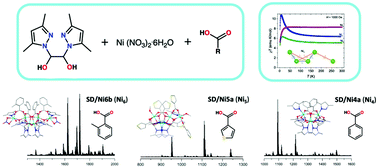Carboxylic acid-tuned nickel(ii) clusters: syntheses, structures, solution behaviours and magnetic properties†
Abstract
Three novel cicada-like nickel(II) clusters, formulated as [Ni6(bdped)2(mba)6(Hdmpz)2(NO3)2(H2O)2]·4MeCN (SD/Ni6b), [Ni5(bdped)2(tca)6(Hdmpz)(MeOH)2(H2O)]·MeOH (SD/Ni5a) and [Ni4(Hbdped)2(ba)4(Hdmpz)2]·2NO3·2MeCN (SD/Ni4a), were obtained by tuning the auxiliary carboxylic acids, where H2bdped = 1,2-bis-(3,5-dimethylpyrazol-1-yl)-ethane-1,2-diol; Hmba = 2-methylbenzoic acid; Hdmpz = 3,5-dimethyl-1H-pyrazole; Htca = 3-thiophenecarboxylic acid; and Hba = benzoic acid. The structures of SD/Ni6b, SD/Ni5a and SD/Ni4a are built from a central Ni4O4 opened cube, appending two to zero NiNO5 octahedra. The solution behaviours of SD/Ni6b, SD/Ni5a and SD/Ni4a were studied in detail via an ESI-MS technique and their solution stabilities were confirmed. Magnetic analysis indicated the presence of Ising-type anisotropy: D = −13, −10, and −11 cm−1 for SD/Ni6b, SD/Ni5a, and SD/Ni4a, respectively; moreover, dominantly ferromagnetic interactions were found between magnetic centers: J1 = 6.5 cm−1, J2 = −0.44 cm−1 and J1 = 5.9 cm−1, J2 = 2.6 cm−1 for SD/Ni5a and SD/Ni4a, respectively. Besides, the photocurrent signals were observed and they reached the maximum very quickly for these three nickel(II) clusters and then their current intensities remained almost constant, which provide a possibility to be used for light-harvesting and photo-related catalysis.



 Please wait while we load your content...
Please wait while we load your content...